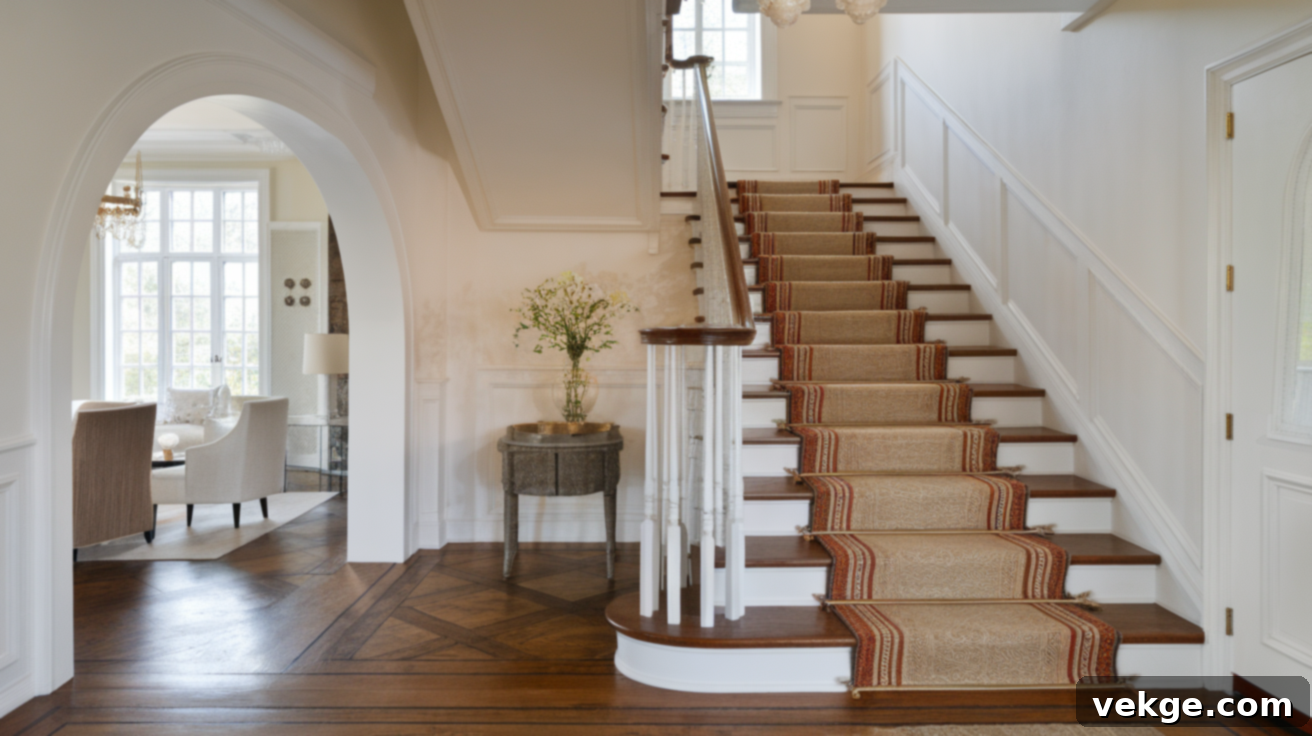Elevate Your Home: The Ultimate Guide to Choosing and Installing Stair Runners for White Stairs
White stairs offer a pristine, elegant foundation, acting as a clean canvas that can dramatically transform the aesthetic of your entire home. While beautiful on their own, adding a stair runner introduces an unparalleled blend of beauty and functionality. This simple yet impactful addition not only protects your investment from daily wear and tear but also injects a unique personal touch and warmth into your living space, making your staircase a true focal point.
In this comprehensive guide, we’ll delve into everything you need to know about perfectly pairing stair runners with white stairs. From selecting the ideal materials and captivating patterns to mastering installation techniques and ensuring long-term maintenance, we’ve got you covered. Whether your home embodies modern minimalism, a cozy farmhouse charm, or a timeless traditional elegance, the right runner has the power to completely redefine the feel and character of your staircase.
Join us as we explore how this thoughtful addition can make your white stairs not only safer and quieter but also significantly more visually appealing, tying together your home’s design with effortless grace and style.
Choosing the Perfect Stair Runner for White Stairs
Adding a carefully selected runner to your white stairs is a fantastic way to introduce warmth, sophisticated style, and enhanced safety to your home. Beyond its aesthetic appeal, the right stair runner acts as a crucial protective layer, shielding your beautiful white stairs from the constant foot traffic, scratches, and scuffs that accumulate over time. When paired with the crisp backdrop of white stairs, runners create a strikingly clean and impactful look that can instantly elevate the entire ambiance of your hallway or entryway, leaving a lasting impression on guests and residents alike.
Popular Materials for Stair Runners
The material of your stair runner is a pivotal choice, influencing both its visual appeal and its longevity. Different fiber types offer distinct advantages, making some options more suitable for various homes depending on factors like the volume of foot traffic, the presence of pets or children, and your preferred cleaning routine.
Textile Options
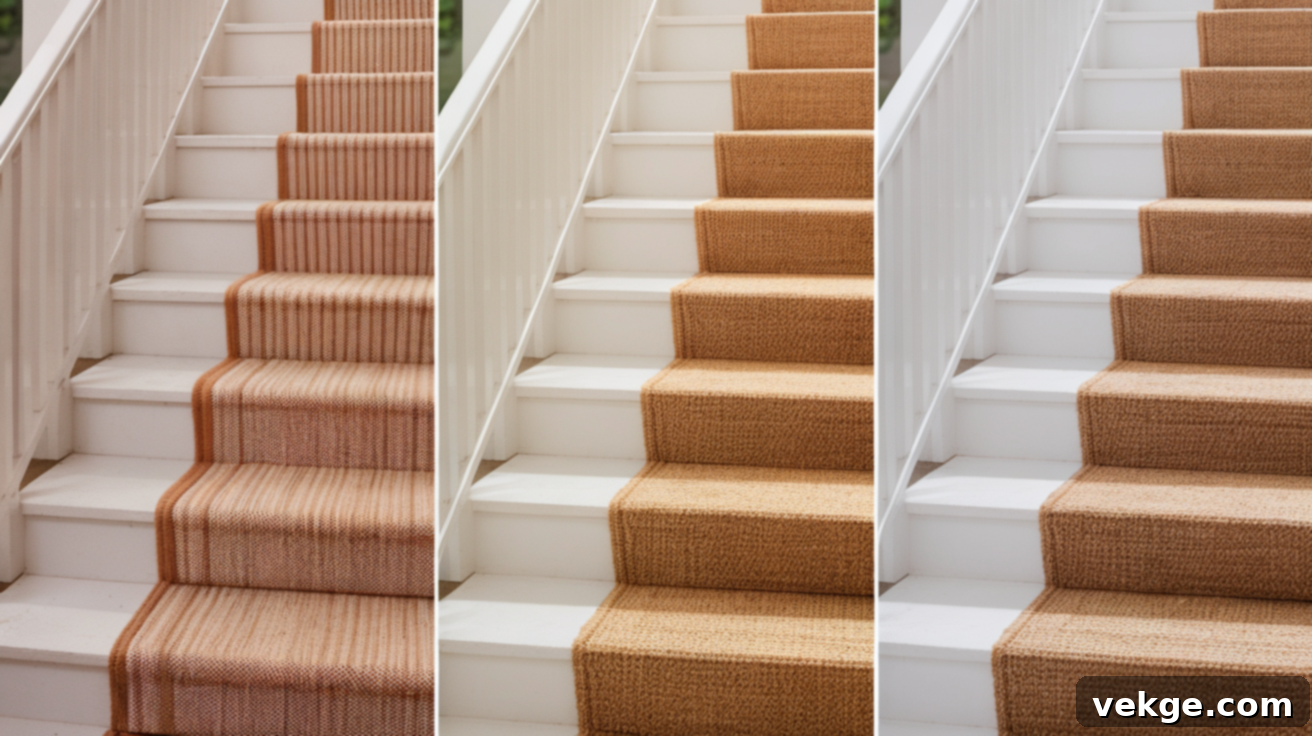
When considering textile options, wool runners stand out for their exceptional comfort, natural resilience, and long-lasting quality, making them a luxurious choice for white stairs. Their soft texture feels wonderful underfoot, and wool naturally resists crushing and soiling. For those seeking a more organic and textured aesthetic, natural fibers like sisal and jute bring an earthy, rustic charm that beautifully complements the clean, bright backdrop of white. These materials offer a unique tactile experience and an understated elegance. Similarly, seagrass runners, often highlighted in design blogs like Sand and Sisal, provide remarkable durability coupled with an appealing organic feel, ideal for adding a touch of natural serenity to your staircase.
Synthetic vs. Natural Fibers
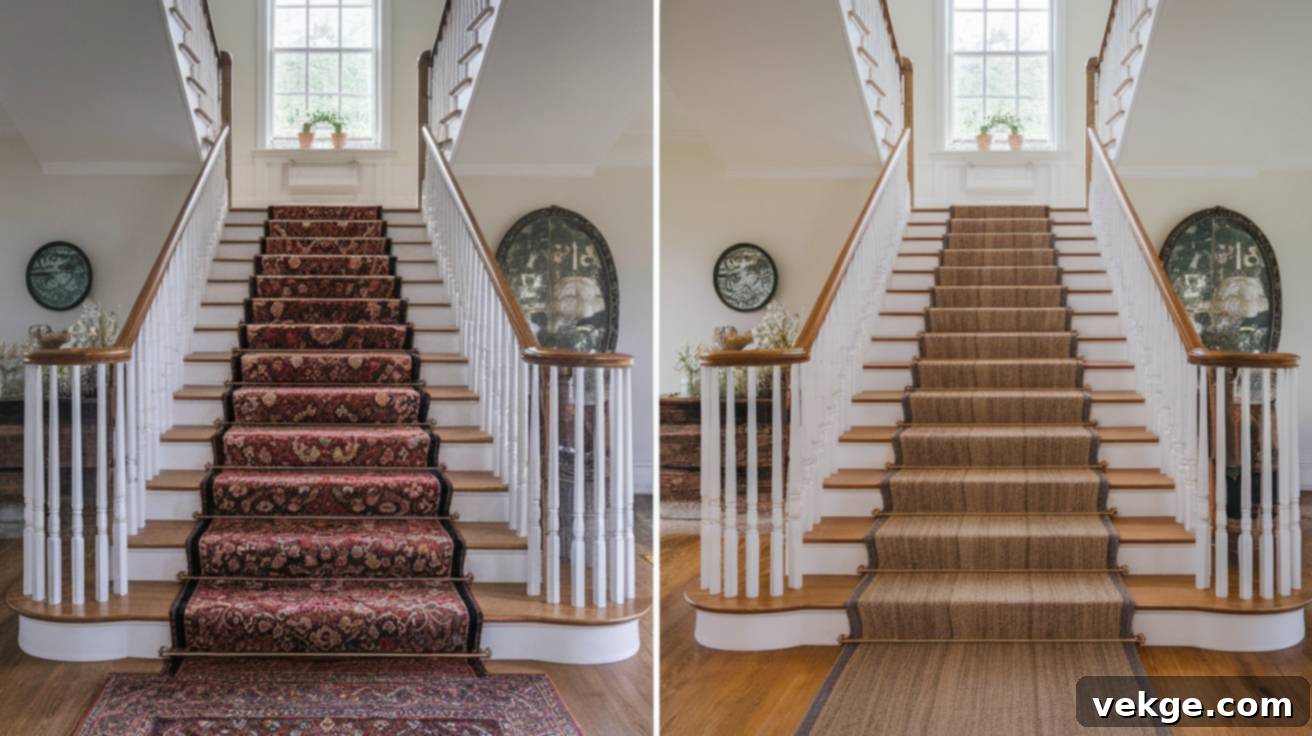
The debate between synthetic and natural fibers often boils down to a balance of aesthetics and practicality. Natural fibers, such as wool, sisal, or jute, undoubtedly offer unparalleled beauty, rich texture, and a luxurious feel. However, they can be more prone to staining and may require more meticulous care, especially against the pristine backdrop of white stairs where any discoloration would be prominent. On the other hand, synthetic options like nylon, polyester, or polypropylene are engineered for superior performance. They are highly resistant to staining, fading, and wear, making them exceptionally easy to clean and an ideal choice for busy households with high foot traffic, kids, or pets. While natural materials often feel more comfortable and substantial underfoot, they may show wear more quickly in heavily trafficked areas, whereas synthetics are designed to withstand the rigors of daily life with greater resilience.
Durability and Maintenance
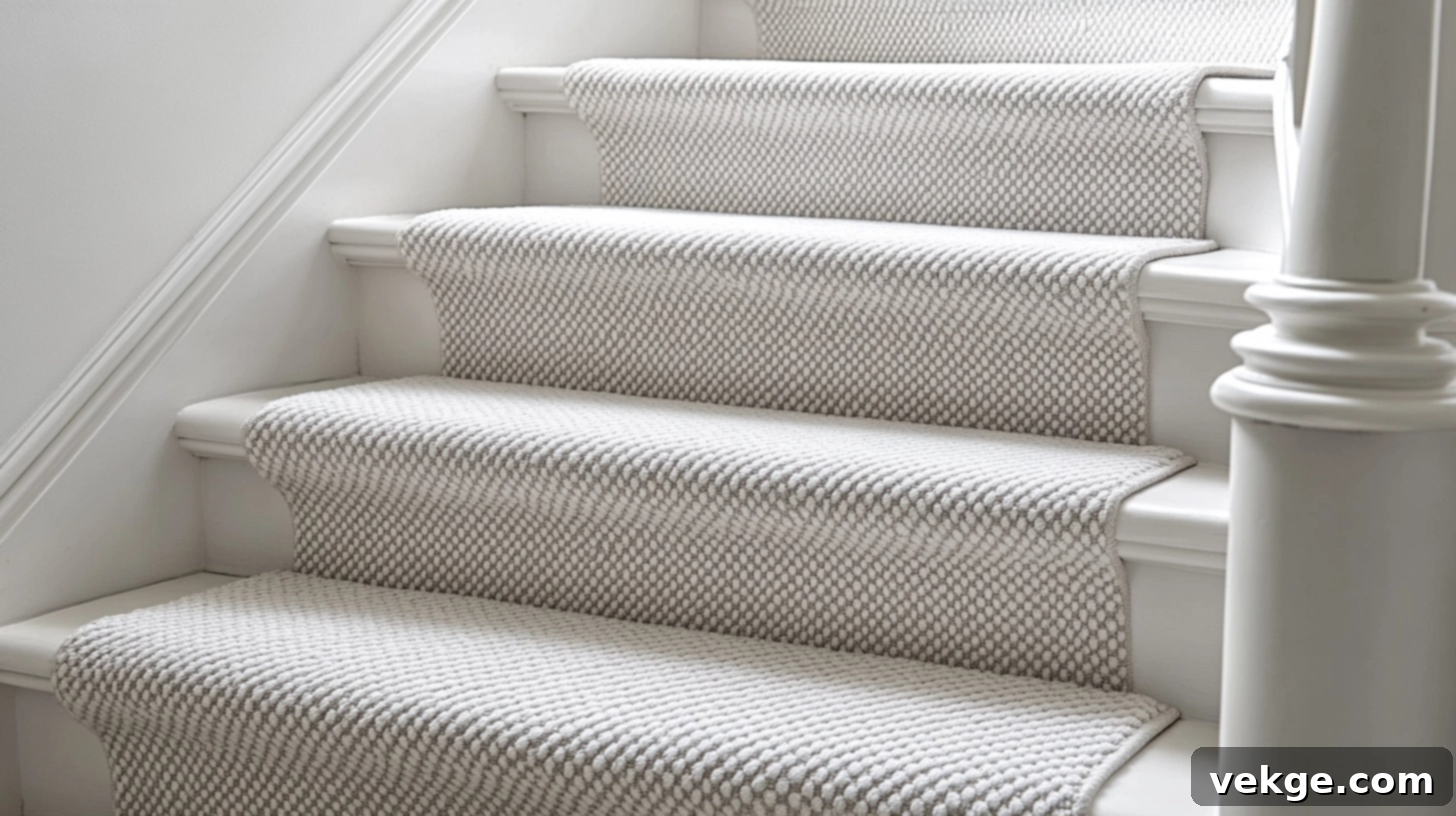
The durability and maintenance requirements of your stair runner material are crucial considerations for its long-term performance, especially when protecting your white stairs. Wool, renowned for its natural crimp, stands up exceptionally well to heavy foot traffic, maintaining its appearance and bounce for years. However, it does require more careful cleaning, often benefiting from professional carpet cleaning to maintain its pristine condition. Synthetic runners, by contrast, are generally much simpler to maintain. Regular vacuuming is usually sufficient, and most spills can be blotted and spot-cleaned with relative ease due to their stain-resistant properties. Natural fibers like sisal and jute, while durable in their own right, demand gentle cleaning methods, typically dry cleaning or immediate spot treatment, to prevent water damage or discoloration, which is a crucial factor when they are installed over sensitive white-painted stairs. Understanding these maintenance needs upfront ensures your runner and stairs remain beautiful for years to come.
Pattern and Design Ideas for White Stairs
The clean, neutral canvas of white stairs offers an incredible opportunity to experiment with a vast array of pattern and design options for your runner. The right design can act as a powerful design element, effortlessly tying together your home’s overall aesthetic and adding visual interest to an often-overlooked area.
Solid vs. Stripes
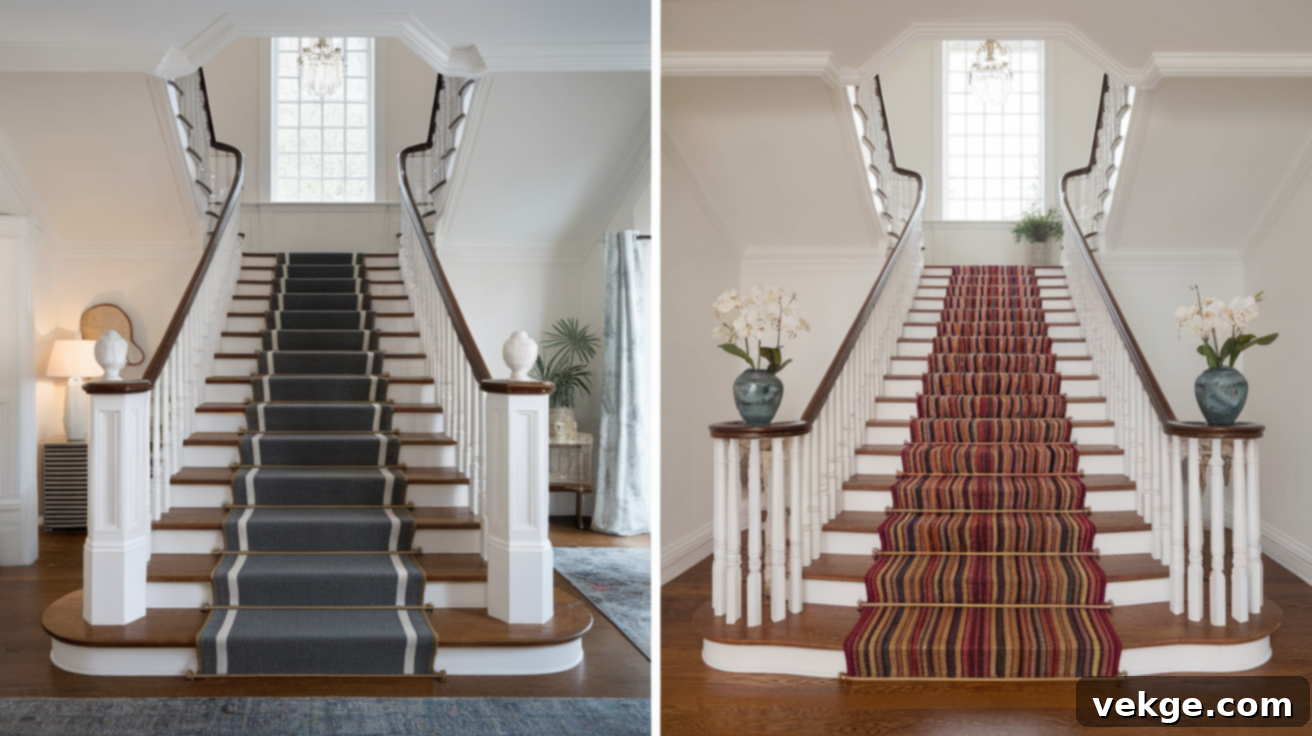
Choosing between solid-colored and striped runners can dramatically alter the perception of your white stairs. Solid-colored runners create a sense of calm, continuity, and sophisticated uniformity. They allow the architectural beauty of the white stairs to shine through, providing a soft contrast or a bold statement depending on the color chosen. On the other hand, striped patterns introduce dynamic visual interest and can play clever tricks on the eye. Vertical stripes, for instance, can make stairs appear longer and more elegant, drawing the eye upward, while horizontal stripes can create an illusion of wider treads. The inherent contrast between the crisp white stairs and a well-chosen patterned runner, especially stripes, creates a pleasing visual effect that adds depth and character to your staircase.
Complementing White with Color
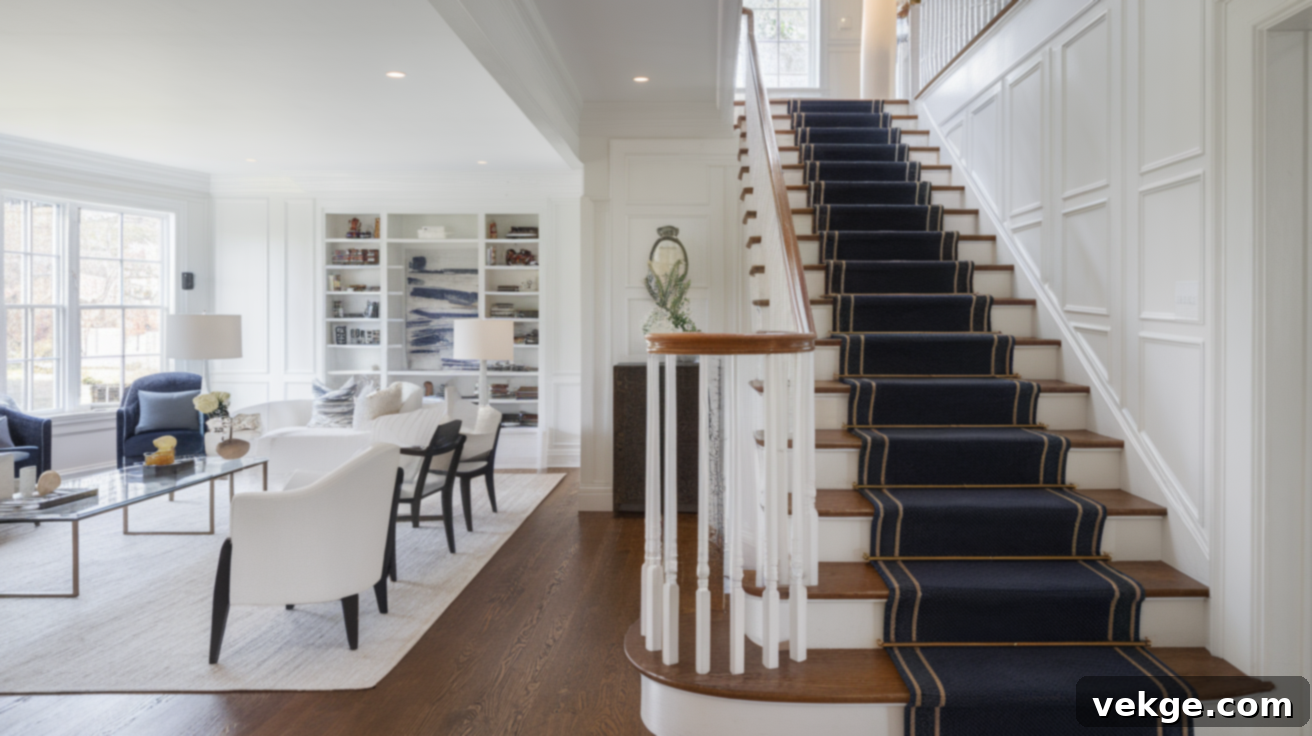
The versatility of white stairs makes them an ideal backdrop for a wide spectrum of colors. Gray runners, such as the elegant Long Island White/Gray style from Runrug, offer a subtle, sophisticated contrast that complements contemporary and minimalist interiors without overwhelming the space. For those seeking a more classic and bold statement, navy or black runners create timeless and striking pairings with white, evoking a sense of traditional grandeur or chic modernity. These high-contrast choices make a dramatic impact. Alternatively, neutral tones like beige, tan, or light brown (as beautifully exemplified by a Pinot Grigio runner) blend seamlessly with white for a warm, inviting, and timeless look that enhances natural light and creates an airy feel. Consider the existing color palette of your surrounding living spaces when making your selection to ensure a harmonious flow.
Geometric and Modern Patterns
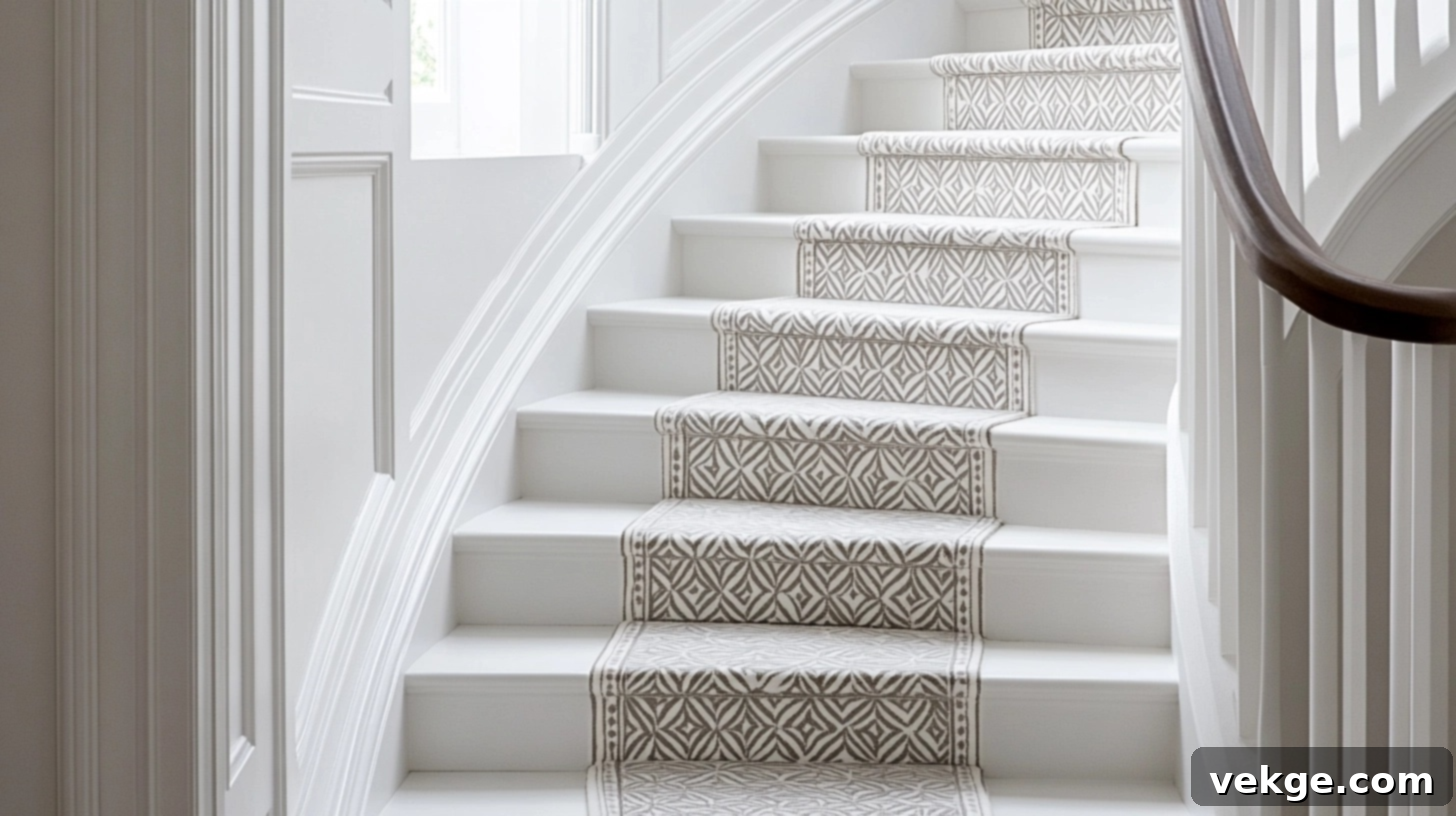
For homes with a contemporary edge, geometric and modern patterns are an excellent choice to revitalize white stairs. Simple shapes, clean lines, and abstract designs can make your white stairs look current and stylish without appearing too busy or overwhelming. These patterns work exceptionally well in updated homes, providing a fresh, artistic flair while still honoring the classic appeal of white stairs. The right modern pattern has the unique ability to tie together the entire home’s style, acting as a bridge between different design elements and creating a cohesive, well-curated environment. From subtle diamonds to bold chevrons, geometric patterns add architectural interest and a sense of movement to your staircase.
Styling Your White Stairs with a Runner: A Design Statement
White stairs provide the ultimate blank canvas for creative styling with runners. Far from being just a utilitarian pathway, the right runner transforms your staircase into a significant design feature, elevating it from a simple means of access to a central element of your home’s aesthetic. Your choice of runner should thoughtfully reflect both your personal style and how the staircase integrates into your overall home layout, creating a seamless and inviting transition between floors.
Matching the Runner to Your Home’s Decor
To achieve a harmonious and polished look, the stair runner you choose should feel like a natural, organic extension of your home’s existing style. This thoughtful coordination creates visual flow and ensures your white stairs feel intrinsically connected to the rest of your living space, rather than an isolated design element.
Modern and Minimalist Looks

For modern homes characterized by clean lines, uncluttered spaces, and simple color schemes, a gray runner on white stairs creates an effortlessly calm, sophisticated, and put-together look. The Runrug collection, as widely recognized, offers a variety of exquisite options in this contemporary style, providing nuanced shades of gray that can range from light silver to deep charcoal. Black runners, in contrast, make a bold and dramatic statement against white stairs, perfect for homes that already incorporate other black accents or industrial elements. To maintain that coveted modern and minimalist feel, it’s best to keep patterns subtle – think subtle textures, tone-on-tone designs, or simply opt for solid colors that emphasize purity of form and function. This approach ensures elegance without visual noise.
Rustic or Farmhouse Vibe
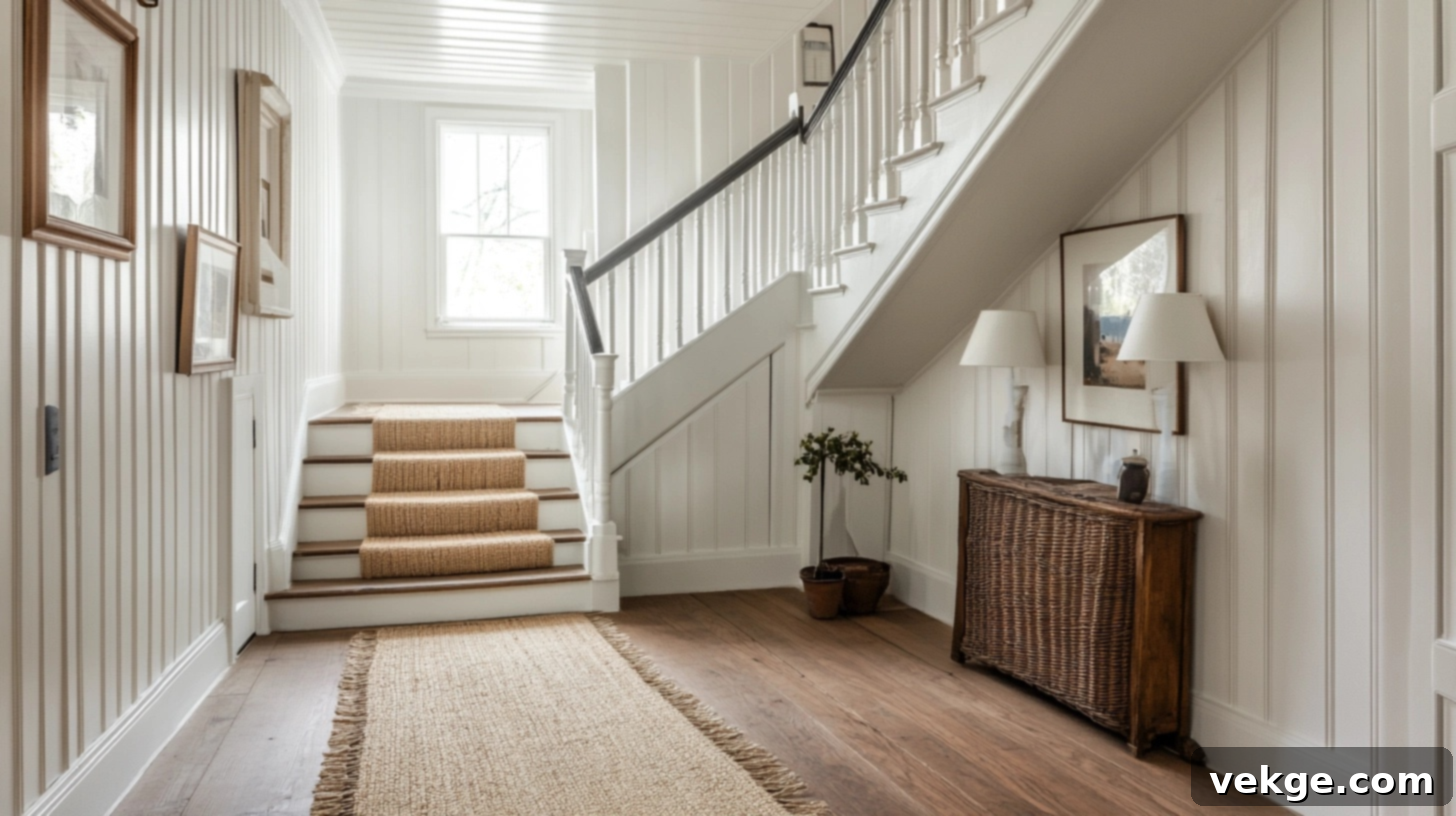
White stairs are a quintessential feature in farmhouse-style homes, and they pair exquisitely with natural fiber runners. Consider materials like jute, sisal, or wool, which inherently add warmth, texture, and an inviting, organic feel to bright white staircases. As often seen in design showcases like “White Painted Farmhouse Stairs,” these natural materials complement the rustic charm and provide a beautiful counterpoint to the crispness of white. Wool runners in warm beige, cream, or subtle plaid patterns are particularly effective in cultivating that cozy, authentic farmhouse feeling. The rich, tactile texture of these natural materials adds significant depth and character to your white stairs, grounding the bright aesthetic without being visually overwhelming or distracting.
Decorative Elements for Your Staircase
Your stair runner is undoubtedly a significant component, but it’s just one piece of the overall staircase design puzzle. Thoughtfully chosen complementary elements can work in synergy with your runner to create a truly finished, cohesive, and impactful look for your white stairs.
Railing Accents

Railing accents offer a fantastic opportunity to enhance the aesthetic of your white stairs and runner. Consider using elegant brass runner bars, which can add a touch of timeless sophistication, especially when paired with a classic black and white runner for a beautifully finished look. If your white stairs feature natural wooden handrails, choose a runner with warm tones or patterns that subtly complement the wood grain and finish, creating a cohesive visual flow. For painted railings, you have the flexibility to either match their color exactly to a tone within your runner for a unified appearance or select complementary colors that create an appealing contrast and enhance the overall design narrative of your staircase.
Lighting Ideas
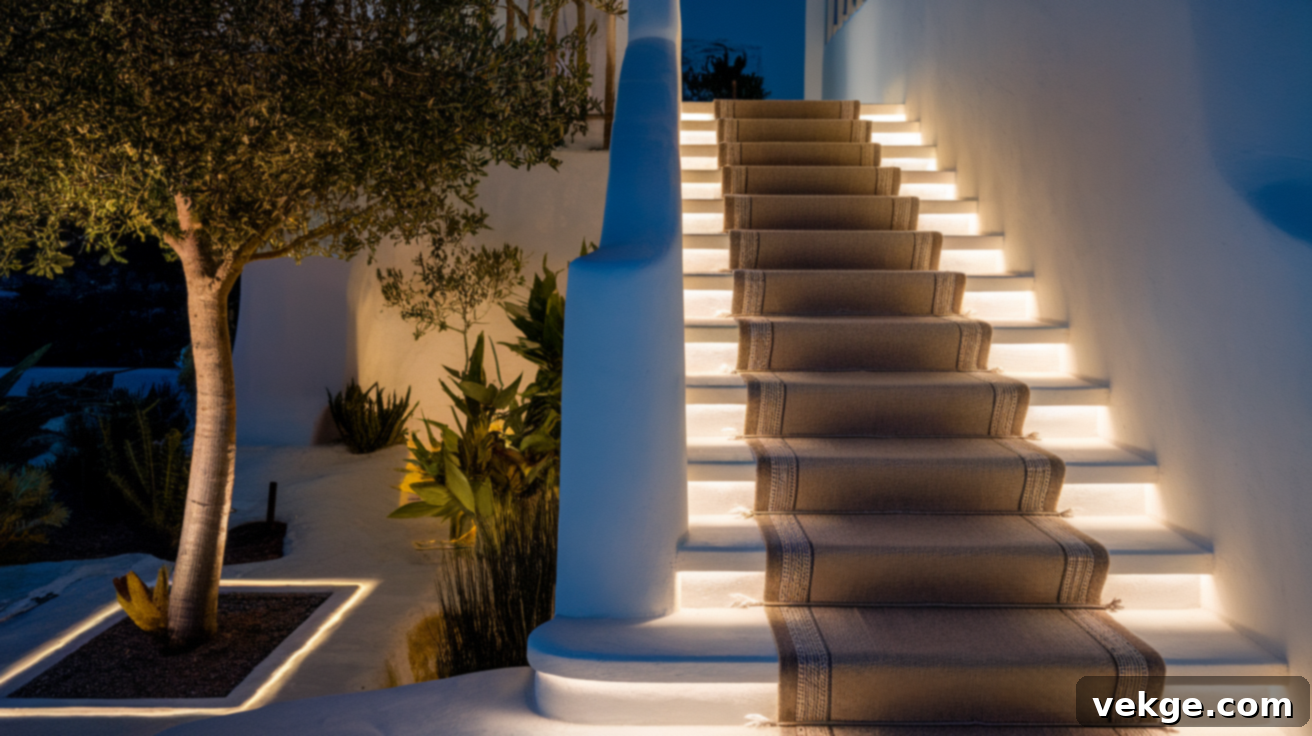
Effective stair lighting and your chosen runner work hand-in-hand to make your white stairs both highly functional and incredibly attractive. Low-profile LED strip lights installed discreetly along the edges or underneath the nosing of white stairs can dramatically highlight the texture and pattern of your runner, especially at night, adding a layer of safety and a touch of modern elegance. Some homeowners opt for small wall sconces strategically placed to cast warm pools of light directly onto the runner, guiding the way and creating an inviting ambiance. The runner’s color, pattern, and texture will significantly influence how light is absorbed and reflected across your staircase, so it’s essential to consider these factors when selecting both your lighting fixtures and your runner to achieve the desired effect and optimize both safety and style.
DIY vs. Professional Installation: What You Need to Know for Your White Stairs
While engaging a professional ensures a flawless, perfectly executed installation, many homeowners successfully take on the task of installing stair runners themselves. The decision between a DIY approach and professional work largely hinges on your personal skill level, the tools you have at your disposal, and the complexity of your specific staircase design. A well-executed DIY job can lead to significant cost savings while still achieving a stunning, high-quality look for your beautiful white stairs.
How to Measure and Install a Stair Runner
Installing a stair runner yourself can be an incredibly satisfying and cost-effective home improvement project. With careful planning, precise measurements, and the right approach, you can achieve professional-looking results that beautifully enhance your white staircase.
- Gather Your Supplies: Before you begin, ensure you have all necessary items. You’ll need the stair runner itself, a heavy-duty staple gun (preferably electric or pneumatic) with 3/8-inch staples (or longer for thicker padding), strong carpet tape, sharp scissors or a utility knife, a tape measure, a ruler or straightedge, and a stair tool (a specialized tool for pressing carpet into the crease of the stair for a tight finish). Don’t forget knee pads for comfort during the process.
- Measure Your Staircase Accurately: This is perhaps the most critical step. Begin by measuring the width and length of each individual stair, including both the tread (the horizontal part where you step) and the riser (the vertical part between treads). For a perfectly centered look on your white stairs, measure the total width of the stair, subtract the width of your runner, then divide the remaining number by two to ensure equal spacing on both sides. This ensures symmetry and a polished appearance. Also, measure the total length the runner will cover, adding an extra 10-15% for waste and adjustments.
- Prepare the Staircase Thoroughly: A clean surface is essential for proper adhesion and a smooth finish. Clean your white stairs thoroughly, removing any dust, dirt, or debris. Inspect for any old staples, nails, or adhesive residue and remove them completely. Fill any minor holes or imperfections with wood filler and apply touch-up paint as needed to ensure your white stairs are pristine before installation.
- Cut and Install the Padding (Optional but Highly Recommended): If you’re using carpet padding underneath (highly recommended for added comfort, noise reduction, and significantly extending the life of your runner and protecting your white stairs), cut individual pieces to fit each tread. These pieces should be slightly smaller than your planned runner width and should not extend over the nose of the stair. Secure the padding to the treads using carpet adhesive or a few staples.
- Position the Runner at the Top: Start at the very top of your stairs. Carefully position the runner, ensuring equal space is left on both sides of your white stairs as determined by your measurements. Allow for 1-2 inches of extra material at the very top, which will be folded under for a clean, finished edge.
- Secure the Top Edge: Fold the excess material at the top neatly underneath the runner. Secure this folded edge to the back of the top stair (where the riser meets the wall/landing) using your staple gun. Place staples every 2-3 inches to ensure it is firmly anchored and won’t pull loose.
- Work Your Way Down, Step by Step: Pull the runner tightly down and against the first riser, ensuring there are no wrinkles or slack. Use your stair tool to push the runner firmly into the crease where the riser meets the first tread. Staple securely at the bottom of the riser where it meets the tread.
- Wrap-Around Treads and Secure: For each subsequent tread, pull the runner tightly over the tread and underneath the nosing (the projecting edge of the stair). Staple underneath the nosing, ensuring the staples are out of sight. Then, pull the runner tightly against the next riser and repeat the process of pushing into the crease and stapling. Maintain consistent tension and alignment throughout.
- Finish at the Bottom: When you reach the very bottom stair, measure and cut the runner with approximately 2 inches of extra length. Fold this excess material neatly underneath and staple it securely to the bottom edge of the last riser or directly onto the floor if it meets flush.
- Hide Staples and Add Finishing Touches: For white stairs, try to place staples strategically where they will be least visible, often along the edges or deep within the pile of the runner. Some DIYers opt to use decorative stair rods or trim pieces at the base of each riser to conceal staples and add an extra layer of finished elegance to their white staircase.
Challenges to Watch Out For
While DIY installation can be rewarding, there are specific challenges that homeowners often encounter. Uneven white stairs, a common occurrence in older homes, can make runner installation particularly tricky. It’s crucial to take the time to measure each individual stair rather than assuming they are all the same size; minor variations can lead to noticeable discrepancies in runner alignment. For stairs with turns, landings, or pie-shaped treads, you may need to carefully cut and join pieces of the runner. Plan these transitions meticulously, ideally by creating templates, to achieve a smooth, seamless, and professional-looking finish. One of the most common issues when installing a runner on white stairs is visible staples. Work with extreme care to place staples where they will be least noticeable against the bright white background, perhaps tucking them deep into the pile or along the edges. Paying extra attention to securing the runner firmly at each turn point and riser base is essential, as this helps prevent shifting and potential slipping over time, significantly enhancing safety. And as many experienced homeowners note, choosing a high-quality runner is just as important as the installation method itself – even the best DIY job won’t look its best with a low-quality runner on beautiful white stairs.
Maintenance and Care for Your Stair Runner and White Stairs
A well-maintained stair runner not only keeps your white stairs looking fresh and inviting but also significantly extends the life of your entire staircase investment. Regular and appropriate care is key to preventing premature wear patterns, maintaining the vibrant colors of your runner, and preserving the stunning clean contrast between your pristine white stairs and the chosen runner.
Cleaning Tips for Stair Runners
Different runner materials necessitate specific cleaning approaches to effectively maintain their appearance and integrity on your white stairs. Adhering to these guidelines will ensure longevity:
- Vacuum Regularly: Use a handheld vacuum or a stair attachment with your regular vacuum cleaner at least once a week, or more frequently in high-traffic areas, to remove dirt and debris before it settles deep into the fibers.
- Rotate Your Runner (If Possible): If your runner is installed in sections or is a continuous roll that can be shifted, consider rotating it yearly. This helps distribute wear evenly and can extend its lifespan, especially in areas where certain steps receive more traffic.
- Blot Spills Immediately: Time is of the essence when it comes to spills. Blot, don’t rub, with a clean, dry white cloth. Rubbing can spread the stain and push it deeper into the fibers. For stubborn spots, use a very mild, material-appropriate cleaning solution.
- Use Material-Specific Cleaners: Always use carpet cleaners specifically designed for your runner material (e.g., wool cleaner for wool, synthetic cleaner for synthetic fibers). Using the wrong product can damage the fibers or cause discoloration.
- Test Cleaning Products First: Before applying any cleaning product to a visible area, always test it on a hidden spot of the runner (like underneath or in a closet) to ensure it doesn’t cause discoloration or damage.
- Handle Natural Fibers with Care: For natural fibers such as sisal, jute, or seagrass, opt for dry cleaning methods whenever possible. Water can cause these fibers to shrink, stain, or become brittle. If you must use a damp cloth, do so sparingly and allow for thorough drying.
- Schedule Professional Cleaning: For wool runners or heavily soiled synthetic runners, schedule professional cleaning at least once a year, or more often for very busy households. Professionals have the expertise and equipment to deep clean without damaging the material.
Protecting White Stairs and Runners
Preventing damage is always easier and less costly than fixing it, both for your beautiful runner and your underlying white stairs. Proactive measures are key:
- Utilize Carpet Padding: Always install high-quality carpet padding underneath your runner. This provides an extra layer of cushion, making the stairs more comfortable and quiet. Crucially, it also prevents the runner from shifting and protects the white stair finish from wear, extending the life of both the runner and the stairs.
- Place Door Mats at Entrances: Strategically place durable door mats at all exterior entrances to your home. This simple step significantly reduces the amount of dirt, grit, and moisture tracked onto your stairs, minimizing wear and the frequency of cleaning.
- Remove Shoes When Possible: Encourage family members and guests to remove their shoes, especially outdoors shoes, when entering the home. This drastically reduces the introduction of abrasive dirt and debris that can prematurely wear down runner fibers and scuff white paint.
- Apply Stain Guard Treatments: Consider applying a high-quality stain guard treatment to new runners before installation, especially for natural fibers or light-colored synthetic options. This creates a protective barrier that repels spills and makes cleaning easier.
- Keep Pets’ Nails Trimmed: For homes with pets, regularly trim their nails. Long or sharp claws can snag, pull, and damage the fibers of your runner, leading to unsightly wear and unraveling.
- Use Clear Plastic Stair Protectors (Temporarily): During parties, moving, or other high-traffic events, consider using temporary clear plastic stair protectors over high-traffic sections. These offer an invisible shield against excessive wear, scuffs, and spills.
- Touch Up White Paint Promptly: Pay attention to your white stairs and touch up any chips, scratches, or worn areas in the paint as soon as they become noticeable. Addressing minor damage promptly prevents it from worsening and keeps your staircase looking fresh and well-maintained.
Conclusion
Adding a thoughtfully chosen stair runner to your white stairs is a transformative decision that brings a wealth of both aesthetic beauty and practical benefits to your home. The right runner acts as a dedicated guardian, protecting your stairs from daily scratches, scuffs, and general wear and tear, thereby preserving your investment. Beyond protection, it significantly reduces noise from foot traffic, creating a quieter and more peaceful home environment, while also providing safer footing, especially for children, seniors, and pets.
White stairs, when complemented by a perfectly selected runner, create a welcoming and impactful entrance that effortlessly ties your home’s overall style together. This combination enhances curb appeal and sets a sophisticated tone for your interior design.
Whether you opt for the precision and peace of mind that professional installation offers or choose to embrace the satisfaction of a well-executed DIY project, the key to lasting beauty lies in selecting materials and patterns that truly align with your lifestyle and harmonize with your home’s existing design. Start with quality materials and ensure proper installation for the best long-term results and enduring elegance.
Ready to embark on the journey of upgrading your staircase? Begin by carefully measuring your stairs and exploring the vast array of runner options that resonate with your personal style and functional needs. Your perfect, transformed white staircase awaits, ready to become a stunning focal point in your home!
